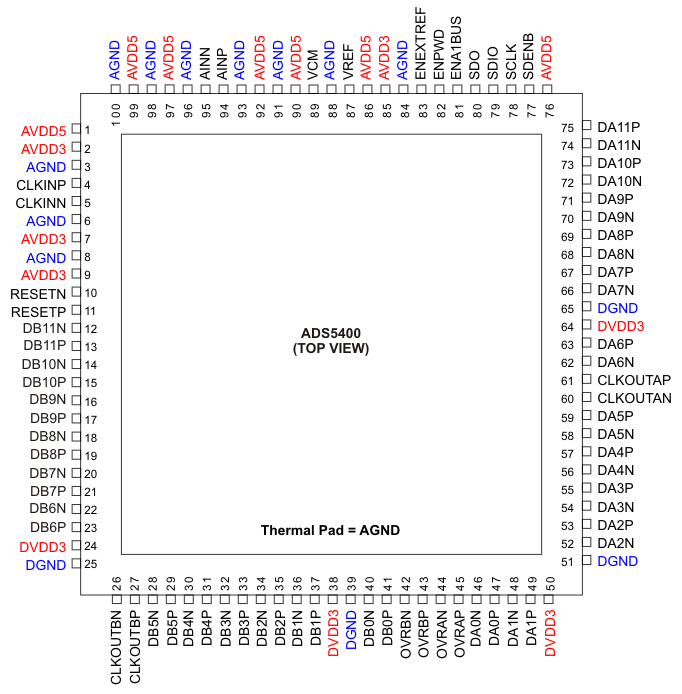SLAS669E September 2010 – may 2020 ADS5400-SP
PRODUCTION DATA.
- 1 Features
- 2 Applications
- 3 Description
- 4 Revision History
- 5 Pin Configuration and Functions
- 6 Specifications
-
7 Detailed Description
- 7.1 Overview
- 7.2 Functional Block Diagram
- 7.3 Feature Description
- 7.4 Device Functional Modes
- 7.5 Programming
- 7.6 Serial Register Map
- 8 Application and Implementation
- 9 Power Supply Recommendations
- 10Layout
- 11Device and Documentation Support
- 12Mechanical, Packaging, and Orderable Information
Package Options
Mechanical Data (Package|Pins)
- HFS|100
Thermal pad, mechanical data (Package|Pins)
Orderable Information
5 Pin Configuration and Functions
HSF package(100)
CFP (TBAR) 100-pins
Top View

Pin Functions
| PIN | DESCRIPTION | |
|---|---|---|
| NAME | NO. | |
| AINP, AINN | 94, 95 | Analog differential input signal (positive, negative). Includes 100-Ω differential load on-chip. |
| AVDD5 | 1, 76, 86, 90, 92, 97, 99 | Analog power supply (5 V) |
| AVDD3 | 2, 7, 9, 85 | Analog power supply (3.3 V) |
| DVDD3 | 24, 38, 50, 64 | Output driver power supply (3.3 V) |
| AGND | 3, 6, 8, 84, 88, 91, 93, 96, 98, 100 | Analog Ground |
| DGND | 25, 39, 51, 65 | Digital Ground |
| CLKINP, CLKINN | 4, 5 | Differential input clock (positive, negative). Includes 160-Ω differential load on-chip. |
| DA0N, DA0P | 46, 47 | Bus A, LVDS digital output pair, least-significant bit (LSB) (P = positive output, N = negative output) |
| DA1N–DA10N, DA1P-DA10P | 48-49, 52-59, 62-63, 66-73 | Bus A, LVDS digital output pairs (bits 1- 10) |
| DA11N, DA11P | 74, 75 | Bus A, LVDS digital output pair, most-significant bit (MSB) |
| CLKOUTAN, CLKOUTAP | 60, 61 | Bus A, Clock Output (Data ready), LVDS output pair |
| DB0N, DB0P | 40, 41 | Bus B, LVDS digital output pair, least-significant bit (LSB) (P = positive output, N = negative output) |
| DB1N–DB10N, DB1P-DB10P | 14-23, 28-37 | Bus B, LVDS digital output pairs (bits 1- 10) |
| DB11N, DB11P | 12, 13 | Bus B, LVDS digital output pair, most-significant bit (MSB) |
| CLKOUTBN, CLKOUTBP | 26, 27 | Bus B, Clock Output (Data ready), LVDS output pair |
| OVRAN, OVRAP | 44, 45 | Bus A, Overrange indicator LVDS output. A logic high signals an analog input in excess of the full-scale range. Becomes SYNCOUTA when SYNC mode is enabled in register 0x05. |
| OVRBN, OVRBP | 42, 43 | Bus B, Overrange indicator LVDS output. A logic high signals an analog input in excess of the full-scale range. Becomes SYNCOUTB when SYNC mode is enabled in register 0x05. |
| RESETN, RESETP | 10, 11 | Digital Reset Input, LVDS input pair. Inactive if logic low. When clocked in a high state, this is used for resetting the polarity of CLKOUT signal pair(s). If SYNC mode is enabled in register 0x05, this input also provides a SYNC time-stamp with the data sample present when RESET is clocked by the ADC, as well as CLKOUT polarity reset. Includes 100-Ω differential load on-chip. |
| SCLK | 78 | Serial interface clock. |
| SDIO | 79 | Bi-directional serial interface data in 3-pin mode (default) for programming/reading internal registers. In 4-pin interface mode (reg 0x01), the SDIO pin is an input only. |
| SDO | 80 | Uni-directional serial interface data in 4-pin mode (reg 0x01) provides internal register settings. The SDO pin is in high-impedance state in 3-pin interface mode (default). |
| SDENB | 77 | Active low serial data enable, always an input. Use to enable the serial interface. Internal 100kΩ pull-up resistor. |
| VREF | 87 | Reference voltage input (2V nominal). A 0.1μF capacitor to AGND is recommended, but not required. |
| ENA1BUS | 81(1) | Enable single output bus mode (2-bus mode is default), active high. This pin is logic OR'd with addr 0x02h bit<0>. |
| ENPWD | 82(1) | Enable Powerdown, active high. Places the converter into power-saving sleep mode when high. This pin is logic OR'd with addr 0x05h bit<6>. |
| ENEXTREF | 83(1) | Enable External Reference Mode, active high. Device uses an external voltage reference when high. This pin is logic OR'd with addr 0x05h bit<2>. |
| VCM | 89 | Analog input common mode voltage, Output (for DC-coupled applications, nominally 2.5V). A 0.1μF capacitor to AGND is recommended, but not required. |